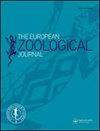Biogenic silica in the Posidonia oceanica “matte”, a tool to discover past dynamics of the sponge community
IF 1.6
4区 生物学
Q2 ZOOLOGY
引用次数: 1
Abstract
Abstract The skeleton of most Porifera species consists of siliceous spicules that, after the sponge death, persist for a long time in the sediment. The reduced suspension occurring within the meadows of the seagrass Posidonia oceanica makes these habitats a stable deposit for sponge spicules. Spicules trapped into the network of rhizomes progressively buried, named “matte”, represent a sedimentary sequence interpretable on a temporal scale. By means of a vertical corer we collected samples of sediment at 0.5, 1, 1.5 and 2 m depth along the matte profile in order to quantify the amount of biogenic silica used to assess past dynamics of the sponge community in four P. oceanica meadows of the Ligurian sea. The content in biogenic silica was determined by spectrophotometric analysis of the sediments. While at Prelo Bay the values are constant in the core sample, a general decreasing trend with depth was observed in the meadows of Punta Pedale, while in the site of Punta Manara the major amount of silica was found deeper in the matte. The temporal variations of sponge abundance were probably due to historical anthropogenic factors. In the meadow of Bergeggi, BSi concentrations, significantly lower compared to all other sites, were likely caused from inputs from the close Savona harbor and strong bottom currents avoiding spicule deposition.海洋Posidonia“冰原”中的生物二氧化硅,一种发现海绵群落过去动态的工具
摘要大多数多孔动物的骨架由硅质针状物组成,这些针状物在海绵死亡后在沉积物中长期存在。海洋海草Posidonia oceanica草地内悬浮物的减少使这些栖息地成为海绵针状物的稳定沉积物。被困在逐渐埋藏的根茎网络中的小穗,被称为“冰晶石”,代表了一个可以在时间尺度上解释的沉积序列。通过垂直取芯器,我们收集了沿冰峰剖面0.5、1、1.5和2米深度的沉积物样本,以量化用于评估利古里亚海四个P.oceanica草甸海绵群落过去动态的生物二氧化硅量。通过沉积物的分光光度分析测定了生物二氧化硅的含量。虽然在Prelo Bay,岩芯样本中的数值是恒定的,但在Punta Pedale的草地上观察到随着深度的增加,总体呈下降趋势,而在PuntaManara的场地上,在冰原深处发现了大量的二氧化硅。海绵丰度的时间变化可能是由于历史人为因素造成的。在Bergeggi的草地上,与所有其他地点相比,BSi浓度明显较低,这可能是由萨沃纳港附近的输入和避免毛刺沉积的强大底流造成的。
本文章由计算机程序翻译,如有差异,请以英文原文为准。
求助全文
约1分钟内获得全文
求助全文
来源期刊

European Zoological Journal
Agricultural and Biological Sciences-Animal Science and Zoology
CiteScore
3.10
自引率
5.60%
发文量
80
审稿时长
30 weeks
期刊介绍:
The European Zoological Journal (previously Italian Journal of Zoology) is an open access journal devoted to the study of all aspects of basic, comparative and applied protozoan and animal biology at molecular, cellular, tissue, organ, organismal, population, and community-ecosystem level. Papers covering multiple levels of organization and integrative approaches to study animal form, function, development, ecology, evolution and systematics are welcome. First established in 1930 under the name of Il Bollettino di Zoologia, the journal now has an international focus, reflected through its global editorial board, and wide author and readership.
 求助内容:
求助内容: 应助结果提醒方式:
应助结果提醒方式:


